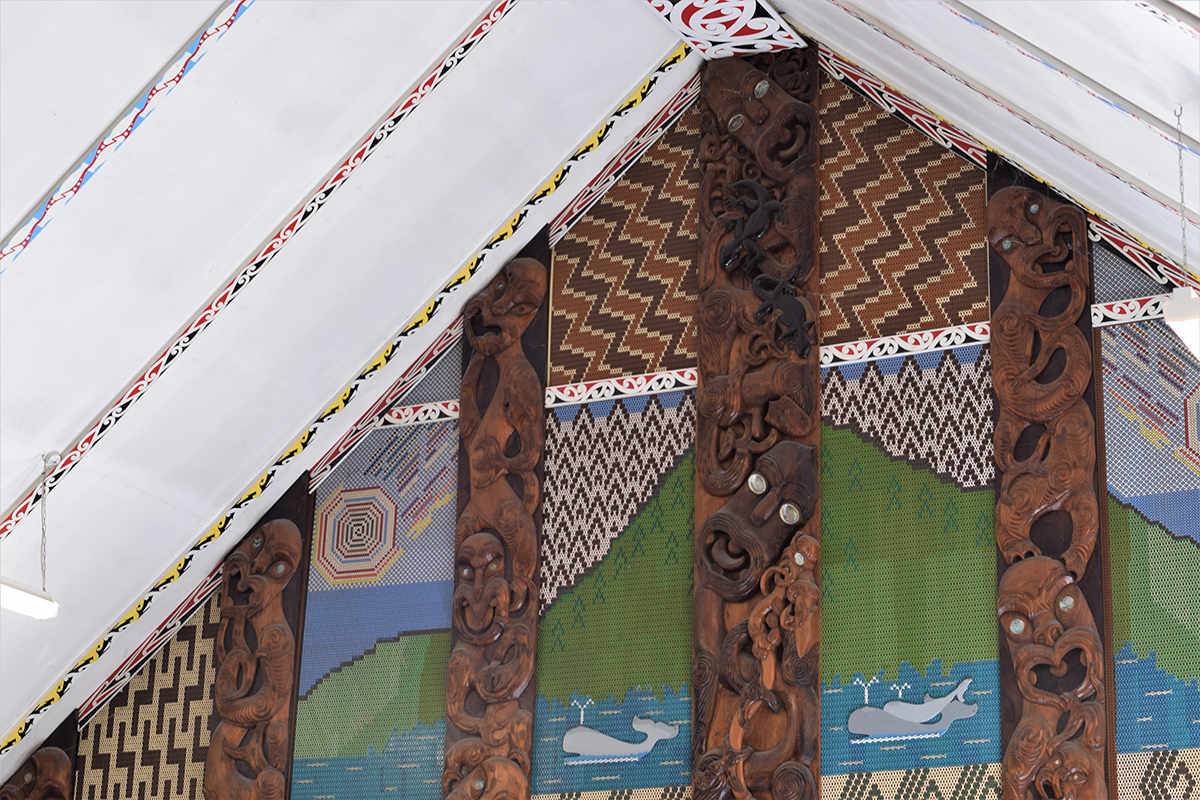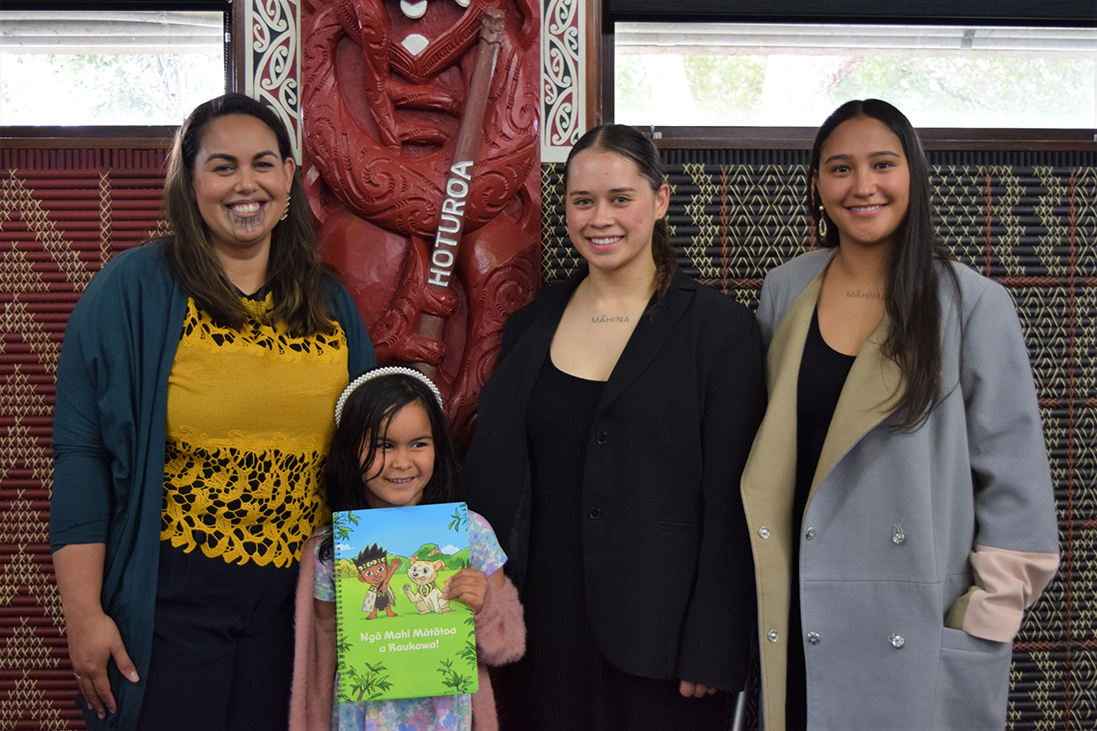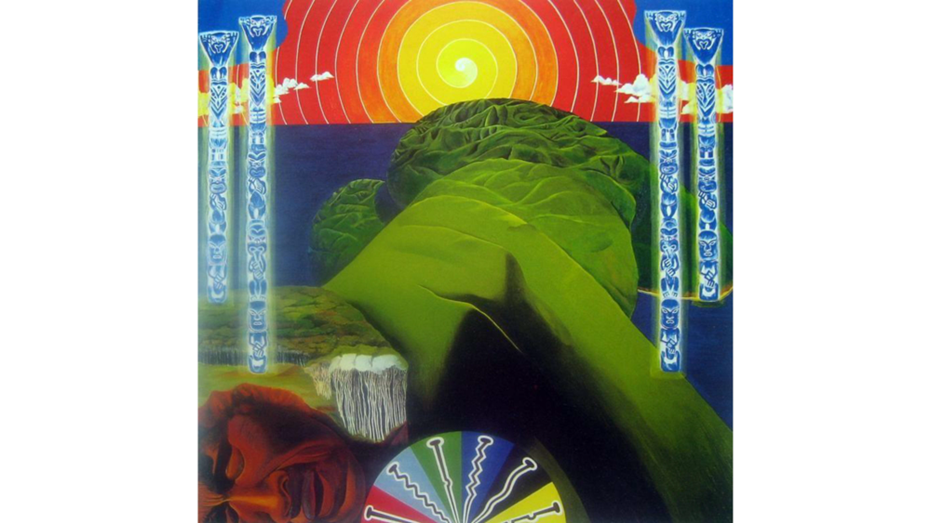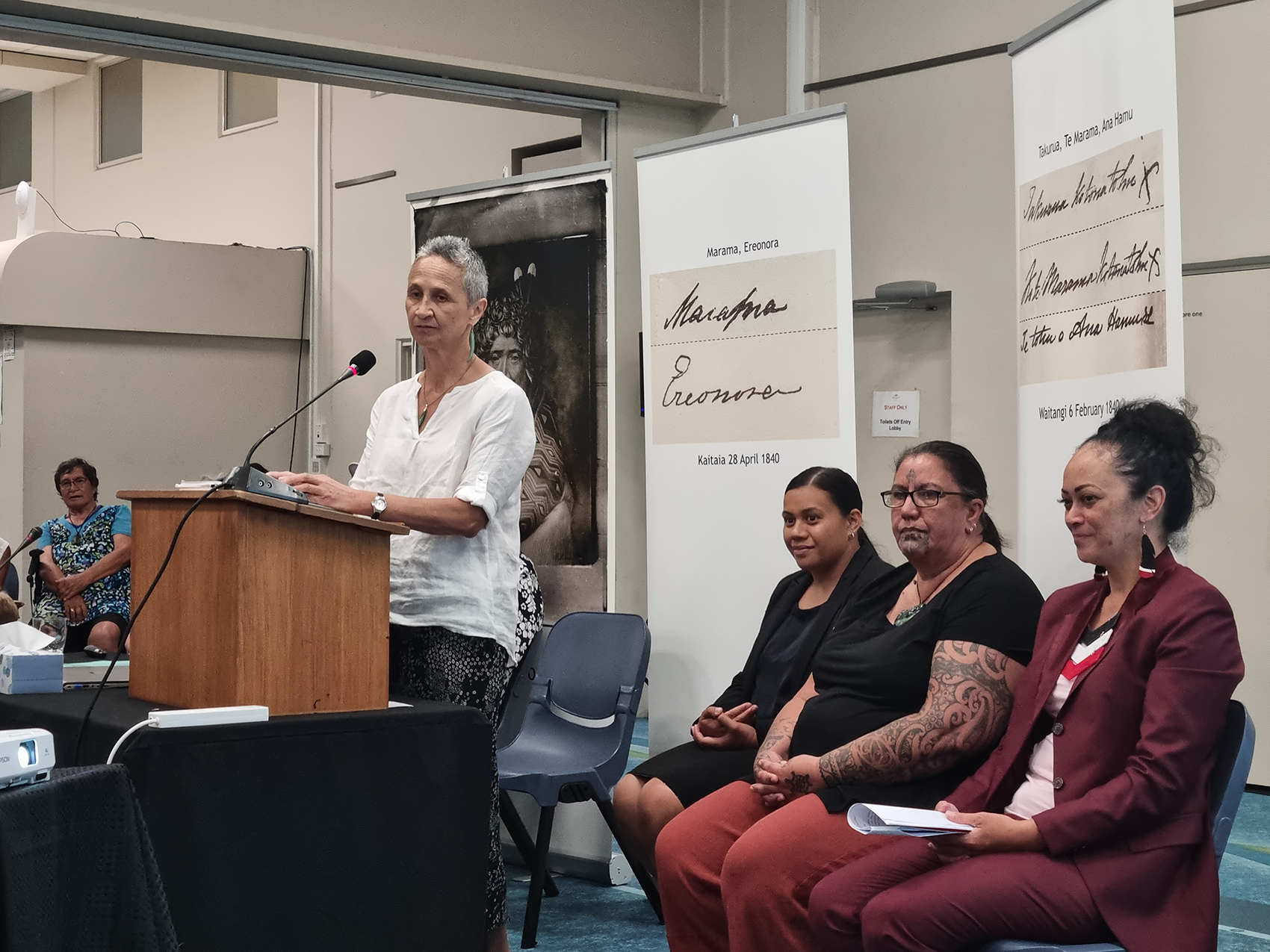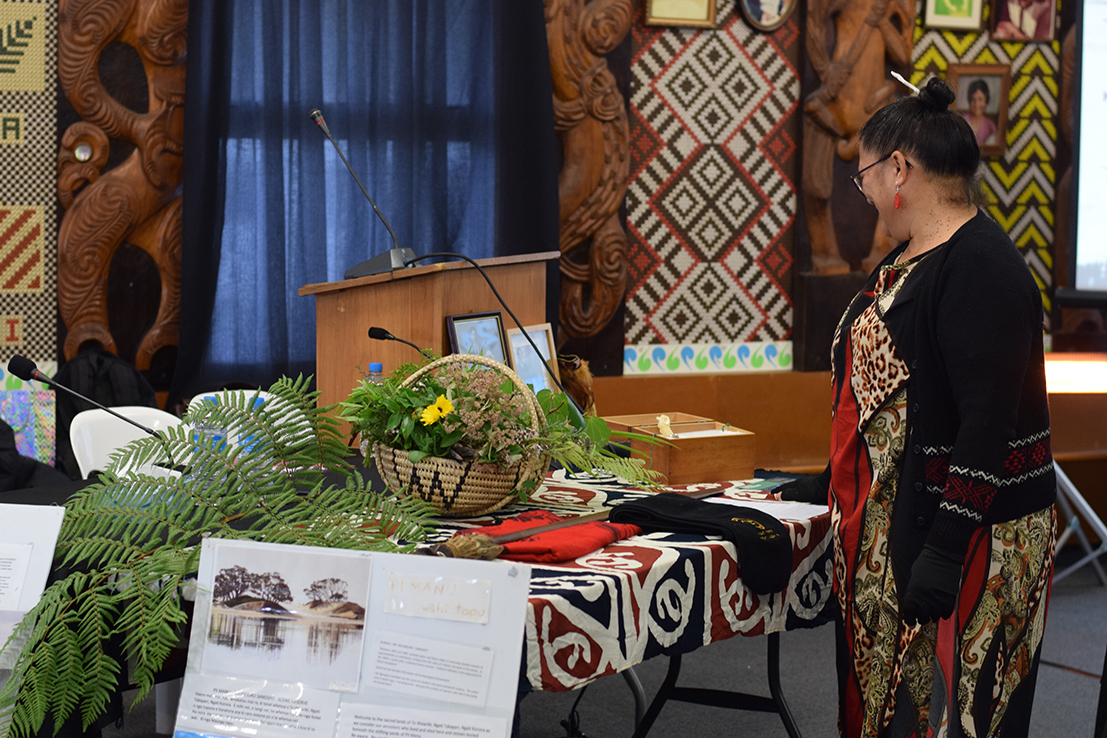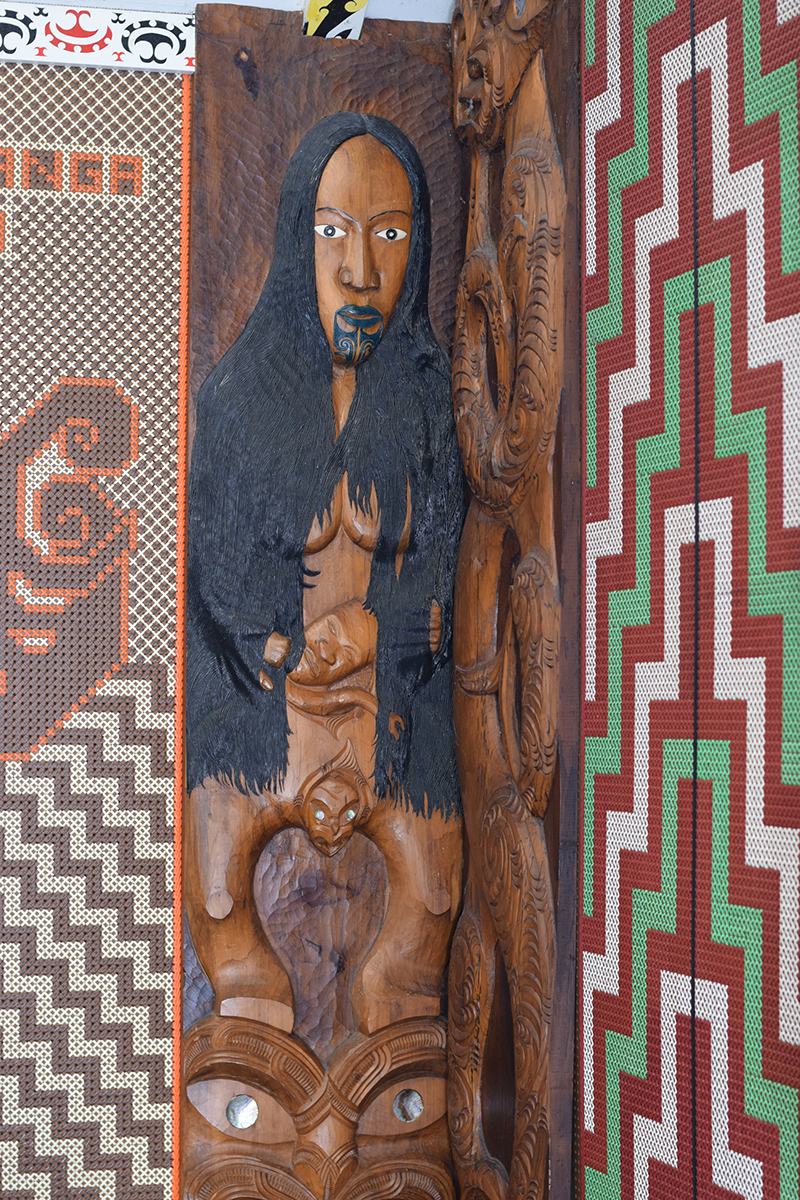The care of tamariki Māori within whānau and hapū
Ko tō te whānau me te hapū manaaki i ngā tamariki Māori
In traditional Māori society, caring for tamariki was a crucial way of upholding whakapapa and connecting past and future. Wāhine Māori played pivotal roles in nurturing tamariki within the whānau and hapū, including bearing and raising children, as well as passing on mātauranga and reo Māori. However, witnesses emphasised that child-rearing was a shared effort, and both men and women took responsibility for intergenerational learning.
Witnesses talked about the practice of whāngai – whereby tamariki are cared for by members of the wider whānau and hapū. They said whāngai was used to develop particular skills or attributes in tamariki, such as whakairo or leadership, or as a way for wāhine who could not have children to contribute to raising the next generation. It also strengthened whakapapa. According to witnesses, decisions about whāngai were made collectively through hui within the whānau or hapū.
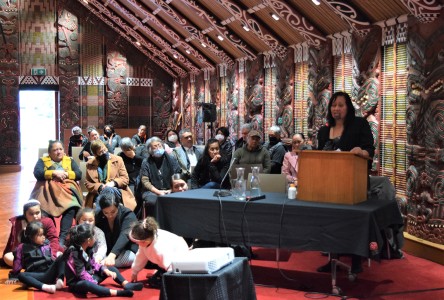
Waitangi Black with whānau at Te Mānuka Tūtahi Marae, Whakatāne, July 2022
Key witnesses who gave evidence
Mere Skerrett (doc A137)(external link) referred to historical sources and academic research that indicated the high status of children in traditional Māori society, including a whakataukī of Kīngi Tāwhiao. Drawing on the work of Professor Dame Anne Salmond in Tears of Rangi: Experiments Across Worlds (2017),(external link) Ms Skerrett also said many European colonial eyewitness reports referred to Māori sharing parental roles and utilising whāngai as a form of collective parenting.
What witnesses said
- “‘Me whakatupu ki te hua o te rengarenga, me whakapakari ki te hua o te kawariki’ … Raise the generations with the fruit of the rengarenga (an abundant spinach like native plant) and strengthen them with the fruit of the kawariki (coprosma). The kawariki is a bitter plant that was given to children to make them stronger. I would argue [this whakataukī of Kīngi Tāwhiao] speaks to the importance of utilising natural resources and specifically references the importance of strengthening children.” (Mere Skerrett, doc A137, p 22)(external link)
- “Manaakitanga was a core value instilled in us as children, ‘me tiaki koe i tō whanau,’ ‘me tiaki koe i tō hapū’ and ‘not just your own children, anyone that was related to you.’” (Moe Milne, doc A62, p 4)(external link)
- “The most important role of wāhine Māori is to the creation and birth of tamariki Māori.” (Materangatira Lily Porter, doc A16(a), p 4)(external link)
- “The role of everyone in the whānau was to support the whānau. Māori were very supportive of keeping their whānau together. The role of wāhine within the whānau was in relation to the birthing and manaaki of tamariki and the old people. Caring is one of their main roles.” (Materangatira Lily Porter, doc A16(a), p 7)(external link)
- “The caring and raising of tamariki was a whānau activity, like many other roles in traditional society. Children were cared for, not only by their parents, but by the wider whānau.” (Patricia Tauroa, doc A60, pp 21-22)(external link)
- “The importance of children in our culture is visible from the word for child – tama-ariki. This importance arises from their centrality to maintaining whakapapa; they are symbolic and the personification of the whakapapa line. Tamariki are also the connection from the original life source the puna or face of the Tipuna. They are the connection between the past and the future to maintain the whakapapa lines, and of course much loved and much cared for. The mauri of a child was to be celebrated and not diminished. Therefore, it was not a parents’ role to ‘discipline’ or ‘control’ a child, rather it was the whānau role to teach, and nurture the child and let their true essence or wairua show through. This was done by having the child alongside in everyday tasks, speaking to them with respect as one would speak to another adult. The child was treated respectfully, unlike today in the context of the nuclear family where the children are seen as supposedly inferior to the parents and grandparents. Children were brought up in an intergenerational learning environment with all the social and cultural richness that this entailed. Fathers were involved in nurturing, caring for and teaching their children.” (Tracy Hillier, doc A92, p 13)(external link)
- “Wāhine were traditionally involved in making strategic decisions in addition to homemaking duties such as caring for children … Women would conduct all child rearing duties when the men went out to fight in wars … Wāhine hold specific knowledge pertaining to their roles and responsibilities. As the principal nurturer to their pēpē, they have a leading opportunity to provide this important knowledge to the next generation (oriori).” (Violet Walker, doc A66, pp 5-6)(external link)
- “Wahine Māori’s exercise of kaitiaki was primarily exercised over children. The care and aroha were shared with the extended whanau. Wāhine were not limited to caring and raising the children of their immediate whanau. This was important when the men went to fight in wars. The whole village partook in raising tamariki.” (Violet Walker, doc A66, p 7)(external link)
- “Whānau is everything in te ao Māori. It was a collective way of living.” (Robyn York, doc A65, p 9)(external link)
- “Whānau, hapū structures in the past provided an infrastructure of support for child rearing and socialisation in cultural values. Children were literally raised by the whanau but the cumulative effect of colonisation, assimilationist policies, cultural and institutional racism and, finally, urbanisation has almost destroyed these structures. The role of women as homemakers in the western nuclear family had no equivalent in pre-European Māori society simply because there was no nuclear family. The concept of women as property, whose practice the colonials brought with them, was unknown. [The] life of the Māori woman was not based on the concepts of ‘motherhood homemaker’. The fact that the three terms – whaea, whaena and koka – are used by different tribes indicates a specific term for ‘mother’ is comparatively recent. Women were child bearers, lovers, writers of waiata, holders of whakapapa, te whare tapere performers, means of procreation and ensuring tribal continuity, but never the individual ‘mother of children’ as defined today. The Māori child was cared for by all relations and had many parents who had equal rights over her or him.” (Donna Awatere Huata, doc A20, p 12)(external link)
- “The basic social unit was the whānau, which usually extended to three generations. Heading the whānau were kaumātua and kuia, respectively, male and female elders, the grandparents of the whānau. The children of the whānau were more likely to be influenced by these elders because kaumātua and kuia were the primary caregivers and educators of the very young, who remained at the village whilst their parents toiled.” (Dr Ella Henry, doc A63, p 9)(external link)
- “Children whose parents belonged to different hapū could claim membership in both hapū, and this could create potential conflict among the tribes in terms of land inheritance, though often the individual’s commitment to the hapū of residence was much stronger.” (Dr Ella Henry, doc A63, p 19)(external link)
- “Once having survived the rigours of childbirth, all writers seem to agree that children were highly valued in the community. Except for the duration of weaning, which could take up to two years, the children were reared by people other than their natural parents, as those were needed in the community labour pool.” (Dr Ella Henry, doc A63, p 23)(external link)
- “Many iwi have stories of tāne wise in the arts of midwifery. It speaks to the intimate relationship between tāne and wāhine as tribal sisters and brothers. This relationship was nurtured through wānanga in which sexuality was talked about openly in the whare tipuna with 4 generations present. Children learned about their own sexual development through osmosis and in the context of whakapapa and karakiatanga korero, historic and cosmological purākau.” (Dr Ngahuia Murphy, doc A67, p 6)(external link)
- “Early missionaries have recorded how they had to teach Māori parents to beat and physically discipline their children, something we did not do in traditional society.” (Dr Ngahuia Murphy, doc A67, p 10)(external link)
- “Wāhine Māori carry their tamariki under their hearts for the duration of their time in Te Pō. … Once the child emerges from the womb, a karanga is sent out welcoming the child from Te Pō, the world of darkness, into Te Ao Marama, the world of light. The babies were usually named after their tupuna, or after a happening. The child will emulate the gifts of that tohunga they are named after.” (Ngaronoa Kimura, doc A139, pp 3-4)(external link)
- “Wāhine Māori are the primary nurturers of their tamariki, starting from when tamariki are in the womb, and then through breast feeding. Wāhine have an essential role in passing our culture and mātauranga knowledge onto the next generation. It flows through feeding, singing (through lullabies), storytelling, and giving unconditional love. The stories that the wāhine Māori told their tamariki were crucial in keeping kōrero tuku iho alive. This was one of the fundamental things that happened while wāhine Māori breastfed their tamariki. Wāhine who have become initiators, carriers and storytellers, were the ones who embedded their young with who they were, where they were, and what tasks lay ahead for them. The stories they told cemented their culture, their land, and their duties to their whanau, iwi and hapū. These wāhine stories told during the infancy stage helped to imbue tamariki with their sense of self identity.” (Ngaronoa Kimura, doc A139, pp 5-6)(external link)
- “The sacredness of life and of womens’ bodies, the collective approach to raising children, and the centrality of children to the wellbeing of our communities, to name a few, must not be forgotten.” (Aroha Rickus, doc A140, p 13)(external link)
- “Traditionally, all children were raised by the village. It was the obligation for all adults and elders to watch over all children of the village. However, the main caretakers of the children were the elders, as they were the holders of knowledge and wisdom. Young parents were deemed more suitable for laborious work that would contribute to the survival and development of the tribe. This was the way of life, until the children were deemed old enough to join their parents, or, until the elder felt that they had taught them the true values and fundamentals of life … Wāhine Māori have a key role in nurturing their whanau and the environment to uphold their culture. The wāhine were the matriarchs of the village, especially during times that the men would go to war. The mana and responsibility she carried was taken seriously, ensuring that the village was well organised, and that the tamariki where well nurtured. This practice was well known to society in those times (Mahi ohu). Collaborative work was paramount for the benefit of the whanau, hapū, and iwi. It is the responsibility of the whanau, hapū, and iwi to take care, of every child that is born into that hapū and whanau.” (Paihere Clarke, doc A141, pp 9-10)(external link)
- “Our customary wāhine Māori approached motherhood with a wide and holistic approach. Whānau, especially grandparents, shared this responsibility. This role was not confined to biology, all wāhine within the iwi were mothers. It did not matter whether they physically gave birth to the tamariki.” (Jane Ruka and Te Miringa Huriwai, doc A53(a), p 8)(external link)
Whāngai
What witnesses said
- “Whāngai means raising a child by kin members other than their birth parents. It means ‘to feed or nourish’ the child in the fullest sense including instruction, culture, and aroha as well as food. Traditionally, to whāngai a child was both a privilege and a responsibility. A privilege because we view the child as a precious taonga; a responsibility because we need to ensure the child is nurtured to their full potential as Māori … Whāngai is a collective caring and nurturing of the child in a Māori way. It transcends beyond the physical feeding and caring for the child. It is about giving spiritual guidance.” (Ellamein Emery, doc A15, p 3)(external link)
- “Children were situated within wider family groupings, not merely to their own nuclear family or in the privacy of households where women were oppressed and subservient to the ‘male’ order of things. Māori very commonly enacted this collective system of parenting called ‘whāngai’ which literally means to feed or nurture. This customary practice meant that grandparents or closely related blood relatives would foster child/ren, especially from large families.” (Mere Skerrett, doc A137, p 23)(external link)
- “Traditionally, whāngai was used to maintain whakapapa connections. Whāngai were (and are) sometimes placed with particular nannies to enable to them to develop particular skills such as fishing, carving, weaving.” (Tracy Hillier, doc A92, p 15)(external link)
- “Whāngai was common practice pre-1840. The whole community accepted responsibility for raising children, not just the mother and father. Grandparents would commonly assist with raising their mokopuna while their parents went out for mahinga kai. All worked collectively to feed hapū members.” (Michelle Marino, doc A111, p 2)(external link)
- “Wāhine would whāngai where they are unable to have children. The placement of whāngai and their destiny were discussed collectively in hui. Everything was discussed collectively in hui. The mana of a wāhine was not reduced or diminished by her not being able to have children. They were not seen in a lesser light. They were loved all the same.” (Violet Walker, doc A66, pp 6-7)(external link)
- “Whāngai happened in the time of our tupuna, and it is something that has continued. The logic behind it was that traditionally, children were raised collectively. So, for women who were unable to have children, it did not affect their mana. Their value as wāhine was not lessened. If anything, they still knew what these children needed and had all that aroha to give.” (Robyn York, doc A65, p 9)(external link)
- “There is the whāngai of tamariki within the whānau where parents had to work, and the tamariki would be brought up by aunties and uncles, or their nannies. The nannie’s motivation was to give the parents a break or to teach the tamariki or to build up a child to fulfil their destiny. Sometimes they might teach their mokopuna about diving or kaitiaki roles, manaakitanga, te reo, or tikanga. They would teach the tamariki about special things that the parents did not have time to teach them about, such as the taniwha, or te maunga. They would teach children the history of the whenua, like that someone died here, and someone had an affair there. They would teach them all that but in a way that it is natural. Sometimes the whānau wants tamariki to learn certain things, certain tikanga. Sometimes tamariki were adopted to learn other relation’s iwi and rohe … Adoption is the real manaaki. Although you would look after your own whānau, it is special when someone goes and adopts someone. We had a lot of adoptions in our whānau. During those times, the Manaaki is all on the adopted tamariki and the tamariki of that whānau get left out. However, the tamariki are taught that the whāngai’d child is special and is one of us. We were not allowed to be jealous. You were to control your wairua because that is what manaaki is.” (Materangatira Lily Porter, doc A16(a), p 8)(external link)
- “Whāngai allows the tikanga of a particular whanau, hapū or iwi to be applied and expanded. For example, the eldest child was whāngai’ed by the grandparents to ensure that they would receive the roles and responsibilities that came with being the tuakana of the whānau. This was to ensure they would acquire the leadership skills required to lead the whanau … The practice of whāngai from pre-1840, was about retaining mana within your whānau. I'll give you the example of Princess Te Puea Hērangi. She took whanui to Tahuna, where my grandfather, Potatau, was. What she did was te whāngai tamariki. Say they were of ariki status, they got taken to certain areas around the tiny district to start up the hapū.” (Paihere Clarke, doc A141, p 10)(external link)
- “Women who were barren, were willing to whāngai the children of other whānau members. In some cases, women became so depressed they begged their relatives to give them a child so that they could experience being a mother and raising a child to adulthood. This does mean that a barren woman was given less mana than a woman who bears children, especially when others realise that she is unable to conceive. I am not aware of the same depression being felt by men, if they ever were aware that they could not father a child.” (Patricia Tauroa, doc A60, p 18)(external link)
- “He mokopuna whāngai tēnei. Ko tōku waimaria i manaakitia au e tōku koroua me toku kuia me te hāpori i roto i mātatoru o te māori motuhake. Ko taku kuia taku ao, ko ia te timatanga me te mutunga. Nāna au i opeope, i ako,i tohutohu, i whakareri mō te ao. Ahakoa i taua wā, kore rawa au i mohio koia tana mahi. Ahakoa he iti noa wā māua moni, wā māua hereni, wā māua rawa. Ko te mea nui katoa nāna i whakakī i waku kete o te mātauranga māori, mātauranga-a-iwi, taku reo me ngā kōrero tuku pūrakau, pakiwaitara, kōrero paki.” (Hera Black-Te Rangi and Mareta Taute, doc A116, p 9)(external link)
